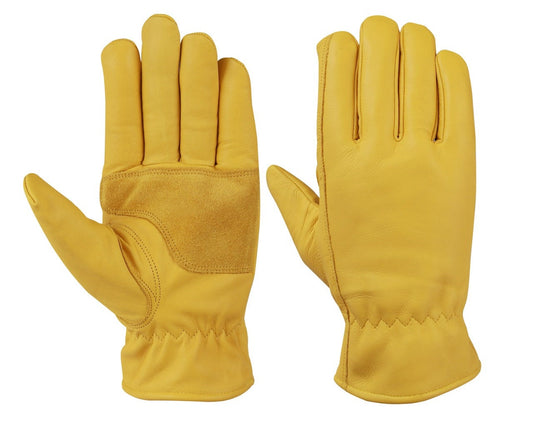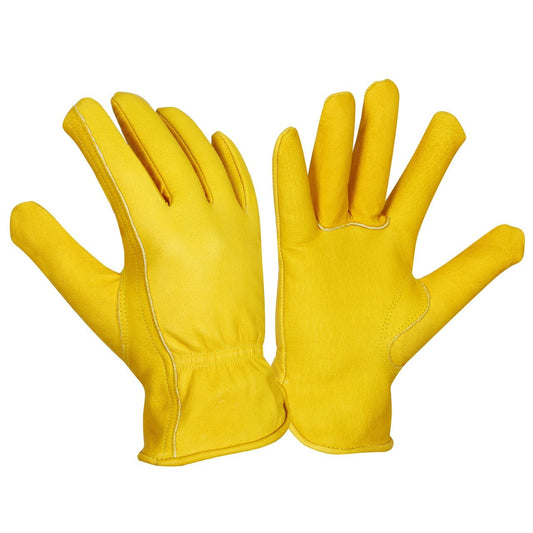Buy Leather Work Gloves
Waspro offers genuine leather gloves that are comfortable, great fit, and made from super soft leather. Our work gloves are proudly made in Canada and are available in different sizes, colors, and designs. These gloves are designed to protect hands from harsh winter, blisters, and cuts.
-
Cowhide Winter Leather Work Gloves
Regular price $34.99 CADRegular priceUnit price per -
Buffalo Winter Leather Work Gloves
Regular price $34.99 CADRegular priceUnit price per
Why Do You Need Work Gloves?
A good pair of work gloves is an essential piece of equipment. By keeping your hands protected, and dexterous, they allow you to work comfortably and efficiently, even in the harshest weather conditions.
The right gloves can make the difference between a comfortable, productive day and a frustrating, potentially painful one.
Types of Work Gloves
Work gloves come in a wide variety, each designed for a particular task or hazard. Here's a breakdown of some common types:
- Winter Gloves: Winter's frosty grip can wreak havoc on your outdoor work. Chilly temperatures not only make you miserable, but they can also seriously impact your ability to get the job done. Winter gloves with proper insulation, like fleece or Thinsulate, keep your hands warm and comfortable, allowing you to focus on the job at hand.
- General Purpose Gloves: These all-rounders offer basic protection for light duty tasks like gardening, yard work, or handling rough materials. They're often made from cotton or synthetic blends and may have a rubber or nitrile coating for improved grip.
- Cut-Resistant Gloves: Essential for anyone working with sharp objects like knives, glass, or sheet metal. These gloves are constructed with Kevlar or other high-strength fibers that can significantly reduce the risk of cuts and lacerations.
- Heat-Resistant Gloves: A must-have for handling hot objects like ovens, grills, or molten materials. These gloves are typically made from leather, aramid fibers, or silicone, and can withstand high temperatures for short periods.
- Chemical-Resistant Gloves: Protect your hands from harmful chemicals like acids, solvents, and oils. These gloves are usually made from nitrile, neoprene, or butyl rubber, and their effectiveness depends on the specific chemicals they're resistant to.
- Electrical-Insulated Gloves: Provide protection from electrical shock. Look for gloves with an ASTM rating that indicates the voltage level they can safely insulate against. Never rely on gloves alone for electrical safety; always follow proper electrical safety procedures.
- Hi-Vis Gloves: Enhance visibility in low-light conditions. These gloves are often made from bright yellow or orange materials and may also incorporate reflective elements.
- Dipped Gloves: These gloves have a thin coating of latex, nitrile, or polyurethane applied to a cotton or nylon liner. They offer a good balance of dexterity and grip, making them popular for tasks like painting, assembly, and automotive work.
Type of Material Used in Work Gloves
Here's a look at some common materials used for work gloves:
- Cotton: Breathable and comfortable, cotton gloves are ideal for general-purpose tasks and provide good dexterity. However, they offer minimal protection against cuts, heat, or chemicals.
- Leather: Durable and heat-resistant, leather gloves offer excellent protection for tasks like welding or handling hot objects. However, they can be stiff and expensive.
- Nitrile: A synthetic rubber known for its excellent puncture and chemical resistance. Nitrile gloves are popular for a wide range of applications, from automotive work to handling food.
- Neoprene: Another synthetic rubber offering good chemical resistance and flexibility. Neoprene gloves are often used for cleaning tasks or working with mild acids and bases.
- Kevlar: A high-strength fiber known for its cut resistance. Kevlar gloves are essential for anyone working with sharp objects.
- Aramid Fibers: Similar to Kevlar, aramid fibers offer excellent heat and cut resistance. They're commonly used in heat-resistant gloves.
How to Find the Perfect Fit Work Gloves
Just like any other clothing item, proper fit is crucial for work gloves. Ill-fitting gloves can be uncomfortable, restrict dexterity, and even be a safety hazard. Here are some tips for finding the right size:
- Measure your hand circumference at its widest point (excluding the thumb).
- Consult the manufacturer's size chart to find the corresponding size for your measurement.
- Try on the gloves before you buy them. They should fit snugly but allow for some movement.
- Consider how you'll be using the gloves. If dexterity is important, you may want to choose a slightly looser fit.
Caring for Your Work Gloves
Work gloves take a beating, but proper care can extend their lifespan. Here's how to keep your gloves in top shape:
- Wash cotton or synthetic gloves regularly according to the manufacturer's instructions.
- Allow leather gloves to air dry naturally after use. You can condition them occasionally with a leather conditioner to maintain their suppleness.
- Store your gloves in a cool, dry place when not in use.
- Inspect your gloves regularly for signs of wear and tear, and replace them when damaged.


